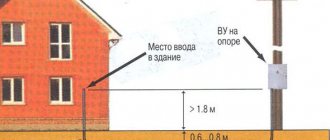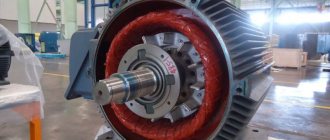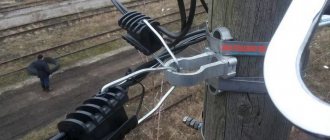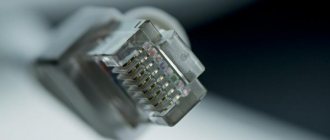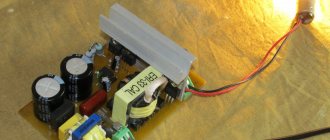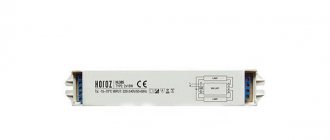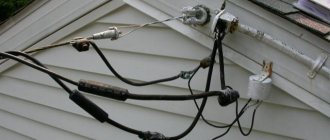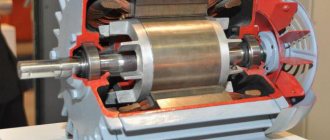But what to do if only two wires enter the area (zero and phase), that is, a single-phase voltage of 220 volts is supplied to the area? There is only one way out - to connect a 380 to 220 V electric motor, for which you can use different circuits.
Connection diagram of a three-phase motor to a single-phase network.
Let’s immediately make a reservation that the best option is to connect an electric motor operating at 380V to a three-phase network. This will ensure both the rated power of the device and the rated rotation, hence the efficiency of the unit. Therefore, any interference with the parameters creates conditions for a decrease in the quality of operation.
Design features
Before starting work, understand the design of the IM (induction motor).
The device consists of two elements - a rotor (moving part) and a stator (fixed unit).
The stator has special grooves (recesses) into which the winding is placed, distributed in such a way that the angular distance is 120 degrees.
The windings of the device create one or more pairs of poles, the number of which determines the frequency with which the rotor can rotate, as well as other parameters of the electric motor - efficiency, power and other parameters.
When an asynchronous motor is connected to a three-phase network, current flows through the windings at different time intervals.
A magnetic field is created that interacts with the rotor winding and causes it to rotate.
In other words, a force appears that turns the rotor at different time intervals.
If you connect the IM to a network with one phase (without performing preparatory work), the current will appear in only one winding.
The torque generated will not be enough to move the rotor and keep it spinning.
That is why, in most cases, the use of starting and operating capacitors is required to ensure the operation of a three-phase motor. But there are other options.
Definition of connection diagram
Regardless of what kind of 3-phase motor you have and how many watts it is, one of two connection schemes will be used.
The first one is called "Star". With this connection, all output contacts of the windings are brought together into a point, and the input contacts into phases. Visually, the connection resembles an asterisk, and is symbolically represented by the game - “Y”.
The advantage of this connection is that the engine is not pressed by “crazy” starting currents and it starts smoothly. The operating currents will also be low, so it will not be possible to use it at its full power.
The second is called "Triangle". In this case, the input of each winding is connected to the output of the previous one, so the circuit resembles a triangle. In this case, the pulsations increase, but the power will be higher. And any jumps at the start can be eliminated if you connect the engine through a capacitor.
How to determine the connection diagram? Before connecting a three-phase motor to 220, it is worth studying the instructions, if any. Also, the data can be located under the cover of the electrical unit or on the housing in the form of a table.
How to connect an electric motor from 380 to 220V without a capacitor?
As noted above, to start an electric motor with a squirrel-cage rotor from a single-phase network, a capacitor is most often used.
It is this that ensures the device starts at the first moment after the single-phase current is supplied. In this case, the capacity of the starting device should be three times higher than the same parameter for the working capacity.
For motors with a power of up to 3 kilowatts and used at home, the price of starting capacitors is high and sometimes comparable to the cost of the motor itself.
Consequently, many are increasingly avoiding containers used only at the moment of start-up.
The situation is different with working capacitors, the use of which allows you to load the motor at 80-85 percent of its power. If they are absent, the power indicator may drop to 50 percent.
However, capacitorless starting of a 3-phase motor from a single-phase network is possible thanks to the use of bidirectional switches that operate for short periods of time.
The required torque is provided by the displacement of phase currents in the windings of the IM.
Today, two schemes are popular, suitable for motors with power up to 2.2 kW.
It is interesting that the start-up time of the IM from a single-phase network is not much lower than in the usual mode.
The main elements of the circuit are triacs and symmetrical dinistors. The first are controlled by multi-polar pulses, and the second by signals coming from the half-cycle of the supply voltage.
Scheme No. 1.
Suitable for 380 Volt electric motors up to 1,500 rpm with delta windings.
The RC circuit acts as a phase-shifting device. By changing the resistance R2, it is possible to achieve a voltage across the capacitor that is shifted by a certain angle (relative to the household network voltage).
The main task is performed by the symmetrical dinistor VS2, which at a certain point in time connects a charged capacitance to the triac and activates this switch.
Connection of electric motor windings with triangle and star
Today, high-power asynchronous electric motors are distinguished by reliable operation and high performance, ease of operation and maintenance, as well as reasonable prices. The design of this type of engine allows it to withstand strong mechanical overloads.
As is known from the basics of electrical engineering, the main parts of any engine are a static stator and a rotor rotating inside it.
Both of these elements consist of conductive windings, while the stator winding is located in the grooves of the magnetic core maintaining a distance of 120 degrees. The beginning and end of each winding are brought out into an electrical distribution box and installed in two rows.
How to connect via capacitors
First, decide which circuit is assembled on the ED. To do this, open the bar cover where the blood pressure terminals are output, and see how many wires come out of the device (most often there are six).
The designations are as follows: C1-C3 are the beginnings of the winding, and C4-C6 are its ends. If the beginnings or ends of the windings are combined with each other, this is a “star”.
The most difficult situation is if six wires simply come out of the housing. In this case, you need to look for the corresponding designations on them (C1-C6).
To implement a scheme for connecting a three-phase electric motor to a single-phase network, two types of capacitors are required - starting and working.
The first ones are used to start the electric motor at the first moment. As soon as the rotor spins to the required number of revolutions, the starting capacitance is excluded from the circuit.
If this does not happen, there may be serious consequences, including engine damage.
The main function is performed by working capacitors. Here it is worth considering the following points:
- Working capacitors are connected in parallel;
- The rated voltage must be at least 300 Volts;
- The capacity of the working capacitors is selected taking into account 7 µF per 100 W;
- It is desirable that the type of working and starting capacitor be identical. Popular options are MBGP, MPGO, KBP and others.
What type of stepper motor do I have?
If you manually rotate the rotor of a switched off engine, you will notice that it does not move smoothly, but in steps. After you have spun the rotor, short-circuit all the motor wires and spin the rotor again. If the rotor spins the same way, then you have a jet engine. If it takes more effort to rotate the rotor, then you have a permanent magnet or hybrid motor. You can distinguish a permanent magnet motor from a hybrid motor by counting the number of steps in one revolution. To do this, it is not necessary to count all the steps, it is enough to roughly understand whether there are less than 50 or more. If it is less, it means you have a permanent magnet motor, and if it is more, it means you have a hybrid motor.
How to connect with reverse
There are situations in life when you need to change the direction of rotation of the motor. This is also possible for three-phase electric motors used in a household network with one phase and zero.
To solve the problem, it is necessary to connect one terminal of the capacitor to a separate winding without the possibility of breaking, and the second - with the possibility of transferring from the “zero” to the “phase” winding.
To implement the circuit, you can use a switch with two positions.
The wires from “zero” and “phase” are soldered to the outer terminals, and the wire from the capacitor is soldered to the central terminal.
Let's first consider how a three-phase motor is connected to a 380V network.
Three-phase motors come with either three terminals - for connection to a star only - or with six connections, with the ability to select a circuit - star or delta. The classic scheme can be seen in the figure. Here in the picture on the left there is a star connection. The photo on the right shows how it looks on a real engine frame.
It can be seen that for this it is necessary to install special jumpers on the required pins. These jumpers come with the motor. In the case where there are only 3 terminals, the star connection is already made inside the motor housing. In this case, it is simply impossible to change the winding connection diagram.
Some say that they did this to prevent workers from stealing units from home for their own needs. Be that as it may, such engine options can be successfully used for garage purposes, but their power will be noticeably lower than those connected by a triangle.
How to connect in a star-delta connection (with three wires)
For the most part, domestically produced EDs already have a star circuit assembled. All that is required is to reassemble the triangle.
The main advantage of the star/delta connection is the fact that the engine produces maximum power.
Despite this, such a scheme is rarely used in production due to the complexity of implementation.
To connect the motor and make the circuit operational, three starters are required.
The current is connected to the first (K1), and the stator winding is connected to the other. The remaining ends are connected to starters K3 and K2.
Next, the winding of the last starter (K2) is combined with the remaining phases to create a delta circuit.
When the K3 starter is connected to the phase, the remaining ends are shortened and the circuit is converted into a “star”.
Please note that simultaneous activation of K2 and K3 is prohibited due to the risk of a short circuit or knocking out of the AV supplying the ED.
To avoid problems, a special interlock is provided, which means turning off one starter when turning on the other.
How to change the direction of rotation
If you need to change the direction only once, then this can be done at the rework stage. To do this, it is enough to swap any two stator windings. The same goal is achieved by transferring a branch of capacitors from zero to phase, or vice versa. But if you need to frequently reverse a three-phase converted motor, a switch is needed. By assembling the electric motor according to the diagram below, you will free yourself from changing the windings every time you need to set the direction of rotation of the shaft in the opposite direction.
There is nothing difficult about converting a three-phase electric motor to a single-phase network with your own hands. The greatest difficulty will be only the calculation of the capacitance of the working capacitor and the experimental selection of the capacitance from the calculated range for the starting accumulator. But this becomes easy if you haven’t lost your technical passport and have a calculator at hand.
More on the topic: - Connection diagrams for asynchronous and synchronous single-phase motors - Connection diagrams for an electric motor via capacitors - Reversible diagram for connecting an electric motor - Do-it-yourself soft start of an electric motor - What is the difference between asynchronous and synchronous motors - Reversible connection of a single-phase asynchronous motor with your own hands - How to check an electric motor - Electric motor repair
Connecting a three-phase asynchronous motor via a frequency converter
To connect three-phase motors to a 220V network, single-phase inverters are used. Although this is not the most budget option, the frequency converter allows you to convert an alternating voltage with a frequency of 50 Hz into a voltage with a frequency from 0 Hz to 1 kHz, and also a pulsed one. Thanks to this, it becomes possible to smoothly start the engine and regulate the speed.
Some inverters have a function for constructing a motor model and the converter itself sets the necessary parameters for operation.
To connect the frequency converter to the motor, shielded cables are used, recommended by the brand manufacturer, with a cross-section corresponding to the power of the selected inverter. The connection is made through the capacitive inputs of the converter; external capacitors are not needed.
Single phase
Now let's talk about another type of asynchronous electric motors.
These are single phase AC capacitor machines. They have two windings, of which, after starting, only one of them works. Such engines have their own characteristics. Let's look at them using the example of the ABE-071-4C model. In another way, they are also called split-phase asynchronous motors. They have another auxiliary winding wound on the stator, offset relative to the main one. Starting is carried out using a phase-shifting capacitor.
Diagram of a single-phase asynchronous motor
From the diagram it can be seen that AVE electric machines differ from their three-phase counterparts, as well as from single-phase collector units.
Always carefully read what is written on the tag! The fact that three wires are output does not mean at all that it is for a 380 V connection. Just burn the good stuff!
